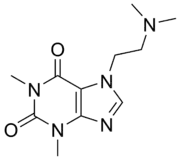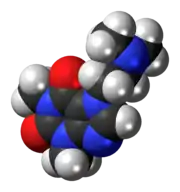 | |
 | |
| Clinical data | |
|---|---|
| Other names | 1,3-dimethyl-7-(2-dimethylaminoethyl)xanthine; 7-(2-dimethylaminoethyl)theophylline |
| Routes of administration | Oral |
| ATC code |
|
| Legal status | |
| Legal status |
|
| Identifiers | |
| |
| CAS Number | |
| PubChem CID | |
| ChemSpider | |
| UNII | |
| CompTox Dashboard (EPA) | |
| ECHA InfoCard | 100.007.516 |
| Chemical and physical data | |
| Formula | C11H17N5O2 |
| Molar mass | 251.290 g·mol−1 |
| 3D model (JSmol) | |
| |
Dimethazan (Elidin) is a stimulant drug of the xanthine class related to caffeine and theophylline.[1] It also has tranquilizing and respiratory-stimulating effects and has been sold as an antidepressant.[1][2]
See also
References
- 1 2 BATTERMAN RC, GROSSMAN AJ, LEIFER P, MOURATOFF GJ (August 1958). "Central nervous system stimulation and sedation with dimethazan". The American Journal of the Medical Sciences. 236 (2): 162–7. doi:10.1097/00000441-195808000-00005. PMID 13559232. S2CID 26657520.
- ↑ O'Neil, Maryadele J. (2001). The Merck index: an encyclopedia of chemicals, drugs, and biologicals. Rahway, NJ: Merck Research Laboratories. ISBN 0-911910-13-1.
| |||||||||||||||||||||
| |||||||||||||||||||||
| |||||||||||||||||||||
| |||||||||||||||||||||
| |||||||||||||||||||||
| Receptor (ligands) |
| ||||||||||
|---|---|---|---|---|---|---|---|---|---|---|---|
| Transporter (blockers) |
| ||||||||||
| Enzyme (inhibitors) |
| ||||||||||
| Others | |||||||||||
See also: Receptor/signaling modulators | |||||||||||
This article is issued from Wikipedia. The text is licensed under Creative Commons - Attribution - Sharealike. Additional terms may apply for the media files.